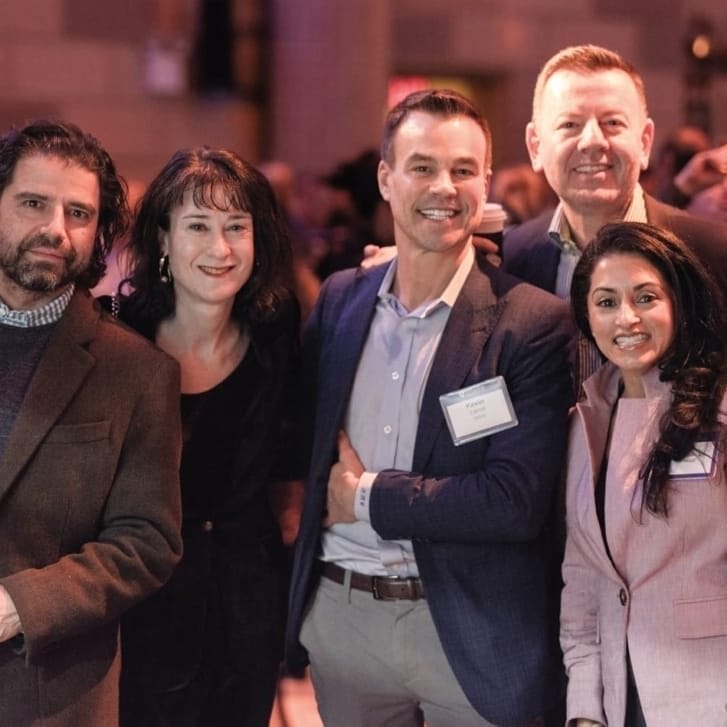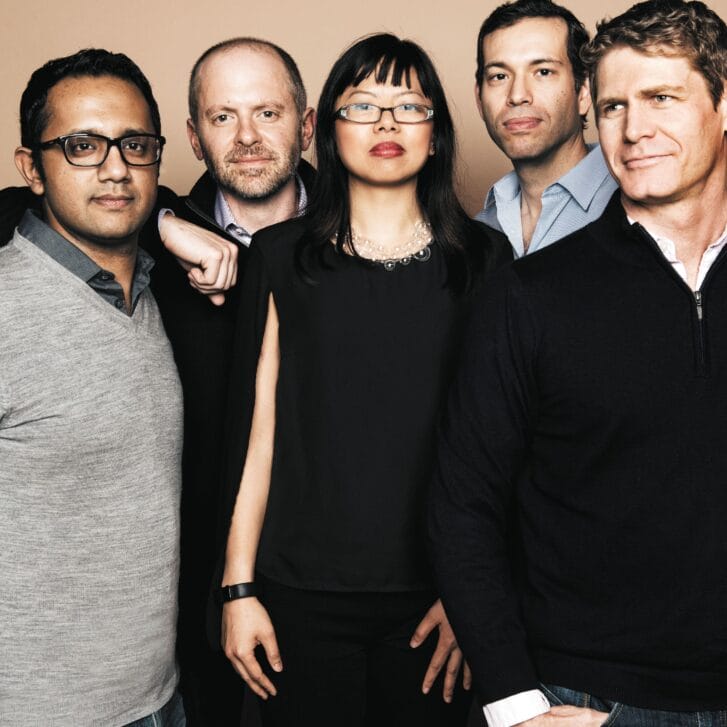On her first job interview after 13 years away from the corporate world, Tina Wallace, W’82, felt like Dorothy in the Wizard of Oz. Instead of the house whirling around her, her own thoughts spun inside her head — the needs of her three children, her husband, her mother. When the interviewer asked if she was ready for full-time work again, she said yes.
He told her he wasn’t convinced.
She didn’t get the job. Says Wallace, “My doubts must have come across.”
Her doubts are gone now. An experienced marketing executive with a Wharton bachelor’s degree, an MBA from the University of Southern California, and 12 years in financial services culminating as a vice president and product manager, she is pursuing the next stage of her professional life with the same zeal that made her successful in her earlier career and as a mother.
Getting Back in the Game
 In March 2007, Wallace participated in Career Comeback: A UBS Fellowship Program for Professional Women Reentering the Workforce, a three-day Wharton Executive Education program designed to facilitate women’s returns to workplace after multi-year breaks. Sponsored by global financial services firm UBS, the program grew out of “Back in the Game: Returning to Business after a Hiatus: Experiences and Recommendations for Women, Employers, and Universities,” an influential study led by Wharton adjunct associate professor of management Monica McGrath.
In March 2007, Wallace participated in Career Comeback: A UBS Fellowship Program for Professional Women Reentering the Workforce, a three-day Wharton Executive Education program designed to facilitate women’s returns to workplace after multi-year breaks. Sponsored by global financial services firm UBS, the program grew out of “Back in the Game: Returning to Business after a Hiatus: Experiences and Recommendations for Women, Employers, and Universities,” an influential study led by Wharton adjunct associate professor of management Monica McGrath.
Conducting the research with support from the Wharton Center for Leadership and Change Management and the Forté Foundation, a nonprofit group that promotes women’s leadership, McGrath enlisted as co-authors two alumnae of the Wharton MBA Program for Executives, Mary Gross, WG’02, then head of learning and development with Merrill Lynch Investment Managers, and Marla Driscoll, WG’01, an independent consultant who was previously a partner at Accenture.
In late 2004 and early 2005, the researchers surveyed 130 executives who had stepped out of the workforce for at least two years and had already returned, or were trying to do so. Of those who responded, 81% had an MBA. Sixty percent had left their jobs within the last five years and 18% within the last 10 years. At the time of the survey, 60% of the respondents had reentered the workforce and 32% were actively seeking employment.
The study revealed that 43% of the women surveyed stayed out of the workforce longer than they expected, and 87% of those who initially never planned to return to work changed their minds, whether due to economic pressures or a reawakened desire for professional challenge. Many reentered by joining smaller companies or by shifting industries or functional roles.
McGrath and her co-authors found that the women often faced a difficult transition.
“Female executives who leave the corporate world when they hit a glass ceiling, want to raise a family full time, or decide to focus on other interests encounter frustrating roadblocks in their attempts to reenter the workforce,” says McGrath, who is academic director for the Career Comeback program and also served as the former director of leadership development for the Wharton MBA program. “To overcome these obstacles, women must update their skills and stay on top of general business trends.”
For those who take the off-ramp from a high-powered career, the on-ramps can be difficult to find. When they were asked to describe their hunt for a job after deciding to return to work, 50% of the survey respondents said they were frustrated and 18% said the experience was depressing. The women were “angry about having to justify the time they took off and start over as if they had never gotten an MBA,” says McGrath.
A Successful Reentry
 According to the research, to overcome the obstacles, women should confront the difficulties they face and prepare for their return to the labor force before they even leave.
According to the research, to overcome the obstacles, women should confront the difficulties they face and prepare for their return to the labor force before they even leave.
Kelly Breslin Wright, WG’98, could serve as a textbook case of smooth exit and reentry to the workplace. While she didn’t plan every aspect of her hiatus, she kept her network active and made adjustments required along the way to secure the flexibility she needed to meet her family responsibilities. Prior to starting a family, Wright left the long hours of management consulting to return to her pre-MBA career of sales. She rose to become Vice President of Client Services at San Francisco’s AtHoc Software before taking a six-month maternity leave following the birth of her first son.
“I thought I would go back to AtHoc, but I wasn’t sure,” she says, calling in from her car while dropping her children off at summer camp. “I didn’t know how I would maintain the balance in my career. I made the decision to come back in a different role.”
Instead of returning as VP of Client Services, she returned to an individual-contributor sales role at a 60% schedule. She found that she could maintain balance and excel in her work without the additional demands of managing direct reports, and she soon returned to full-time hours.
Her work/life mix changed when her second son was born. The family addition coincided with a temporary relocation to Los Angeles that led to an extended leave of absence from AtHoc. When she returned to San Francisco, she continued to stay at home to care for her children to keep a close eye when they faced some health issues. By the time she was ready to reenter the workplace, she had been gone nearly two years — far longer than she had planned — and she had concerns about returning to a full-time schedule.
That’s where her connections from her previous job, from Wharton, and from Stanford, where she earned her undergraduate degree, came in.
She began talking to Tableau Software, a data visualization startup that had been founded as a research project at Stanford and had hired friends of hers among its earliest employees. The company was looking for a vice president of sales to relocate to its headquarters in Seattle.
“I didn’t want to relocate, I didn’t want direct reports, and I didn’t want to work at 100% capacity,” she says. “But I had a track record in sales. People already knew me and had an expectation of what my level of performance would be.”
She began working an 80% schedule from her home office as Tableau’s first salesperson. The fit worked extremely well, and Wright found that she had enough flexibility in her hours to ramp up to full time. Today Tableau has added to its San Francisco staff and opened a satellite office.
Now her children, including stepdaughter MaryKate, and sons Jacob and Ryan, are in school, and Wright says they maintain a balance. “If I worked somewhere that didn’t allow me to leave to volunteer in the classroom or take them to swim lessons, I would quit. There is no question that for me family is my number-one priority. Work is important, but it’s second.”
Making a Career Comeback
For those who lacked the foresight to keep their networks active during work hiatuses, programs like Wharton’s Career Comeback are a valuable resource.
Career Comeback, which will be offered for second time in the spring of 2008, is a highly selective program designed for women with graduate degrees and a minimum of five years of professional experience. Most participants have taken a career hiatus of between two and seven years. While programs with similar goals have been offered by Tuck and Harvard Business School, the Wharton program is the first to be provided to participants at no charge, thanks to financial sponsorship from UBS.
To prepare for the reentry process, participants update critical business knowledge, with a focus on finance, marketing, and strategy, receive career coaching to hone their skills, create transition strategies and action plans for reentry into the workforce, receive one-on-one career coaching, and benefit from faculty research and corporate perspectives.
 For Tina Wallace, the program inspired her to become an advocate for women in similar career transitions. While she originally returned to her marketing career after her first child was born, a few years later she and her husband relocated from Los Angeles to Virginia. The Wallaces were ready to add another baby to the family, so for Tina Wallace, taking time off from paid employment made sense. Eventually she became the mother of three.
For Tina Wallace, the program inspired her to become an advocate for women in similar career transitions. While she originally returned to her marketing career after her first child was born, a few years later she and her husband relocated from Los Angeles to Virginia. The Wallaces were ready to add another baby to the family, so for Tina Wallace, taking time off from paid employment made sense. Eventually she became the mother of three.
“I thought when my youngest was in first grade I’d go back to work,” she says. “Now my youngest is in fifth grade, and I’m finally ready.” In the ensuing years, she had been busy with high-level volunteer work as well as parenting, but her professional network — a continent away — had gone entirely dormant.
Her first step to revive it was joining the Wharton Club of Washington, DC.
“It’s been amazing,” she says. “I entered an established network.” She has also helped shape the club’s agenda to include more resources for alumnae in similar situations. She launched a Career Transitions luncheon group, organized a women’s speaker event, and founded a women’s interest group that allows non-Wharton members to join. She has authored articles, promoted events, and spoken at the last two Joseph Wharton annual dinners.
“When I first joined the club, I felt very green,” she says. “I felt as if everyone knew each other but me. But I’ve found that every volunteer organization is looking for people who are energetic, have ideas, and will take the ball and run with it.”
Wallace heard about the Career Comeback program while attending a Wharton Alumni Leadership Conference. For her the program was another catalyst, one that has helped her translate the skills that she had acquired as a volunteer leader into marketable skills in the workplace.
“Networking takes strength,” she adds. “I spoke with a woman who had been a mentor to me earlier in my career, and she was lovely. I wish I had kept in closer touch all along, but you can’t be shy. Anyone you’re calling would call you if they were in the same situation.”
Wallace is being flexible in her job search, a must for workers seeking reentry. Despite her long resume in financial services, she is also pursuing the greater opportunities in technology that Northern Virginia has to offer.
Her experience tracks closely with the results discovered by McGrath and her colleagues, who found that participants entered into their new job searches with realistic expectations.
However, as the job search continued, many survey participants began to suffer self-doubt, which can spiral, says McGrath. “When they meet resistance, they are taken aback. They are not prepared for it, and they lose confidence.”
Judith Stockmon, WG’94, another Career Comeback alumna, found that increased confidence was one of the biggest values of the Executive Education program. “I have a lot more to sell than I realized,” she says. “I’m finding that when employers aren’t interested in me, it may be that the skill set isn’t a match, but I haven’t gotten negative feedback about time taken away from the workplace.
Stockmon exited full-time work in 2001 after the birth of her first daughter. She left behind her New York-based career as director of marketing communications for the SciFi Channel and Showtime Networks. While pregnant with her second daughter, she relocated with her family to Washington, DC, for her husband’s career. She had intended both the move and the career hiatus to be temporary. Both lasted longer than she anticipated.
Stockmon has stayed active as a fiction and freelance marketing writer, but she is ready to more fully restart her career after six years away from the office.
“I don’t know a woman who has stepped out and who has pursued hefty educational attainments who isn’t interested in making a contribution to society outside the home,” she says. “I don’t know anyone who doesn’t still feel the urge to achieve — it doesn’t go away. It may go dormant for a while, but at some point, it will roar.”
She still experiences some compunctions about the decision. “When you’re sitting on one side of the fence, it looks really great over there,” she says. “But the workplace wasn’t meeting my needs, and it became too difficult to manage both sides. I’m not 100% sure that I want to go back to a full corporate press, but I am 100% sure that I want to resurrect my career.”
Growing Movement Towards Flexibility
The ideal position for Stockmon would be meaningful, remunerative flex-time work — once a rarity but now becoming more common.
Lisa Yom, W’00, is the co-founder of Ivy Exec, a New York-based online job site that posts full-time and flexible jobs specifically for high-caliber professionals with graduate degrees from top universities or the equivalent experience.
“For some, seeking flexible work arrangements may arise from caregiving — taking care of elderly parents or young children,” says Yom. “However, we find that many individuals, regardless of gender, are increasingly seeking greater work-life balance, and that flexibility is enabling this.” She cites a 2006 Universum Study that showed for the first time that male MBAs joined their female counterparts by ranking work-life balance as their top career goal. The perception that flexibility is only a women’s issue is out of date and quickly eroding with changing work cultures.
Says Yom, “Some employers are trying to overcome a perceived stigma on flexible work schedules by redefining these arrangements as a gender-neutral issue. The approach is gaining momentum, especially in the male-dominated financial- services sector where ‘extreme jobs’ with marathon work weeks are commonplace.”
In addition to Wharton’s Career Comeback partner, UBS, leaders include Ernst & Young, which offers 13 types of flexible work arrangements, and Lehman Brothers, which runs an Encore program to recruit experienced female workers back to workplace after hiatuses.
Harry Weiner, WG’06, co-founder of On-Ramps Services LLC, a New York-based recruiting and consulting firm that encourages companies to use flexibility as a key component of recruiting and retention efforts, comments, “You’ll find cultures of flexibility within any field, and it’s driven by the organization. While Lehman Brothers is making great strides, some other investment banks aren’t. So if you’re a woman who’s thinking about the future, it makes sense to consider the needs throughout the whole arc of your career. If you start your career at an employer that isn’t family-friendly, you might get great experience, but you likely won’t end up there. It is much easier to move into flexible work arrangements at a place where you’ve built up a lot of good will.”
He agrees that work-life balance isn’t a gender-specific issue. “We’ve found that both men and women occasionally look around and say, ‘It’s great that I’m making so much money, but it would be even greater if I could have a life.’”
Of the candidates who have joined On-Ramps job site, Weiner has found that 30% have been out of the workforce and are looking to get back in. The remaining 70% are working full-time, but looking for flexible situations so that they don’t have to leave. Of all candidates, 65% to 70% are women. While family responsibilities are the most common reason to pursue flex-time work or a job hiatus, some candidates seek time for entrepreneurial ventures, creative endeavors, education, or other pursuits.
Mary Gross, one of the authors of “Back in the Game,” is a case in point. Except for maternity leaves, she continued her career in financial services, first in finance and then in human resources, without a lengthy break. She chose to pursue her MBA through the Wharton MBA Program for Executives so her career progress would not be interrupted.
Then two years ago, inspired by her work with McGrath, she left full-time employment to pursue a doctoral degree at Rutgers University. Following her own recommendations from the study, she has also maintained her professional network and continued to consult part-time by starting her own company, Human Edge Resources, LLC. She is working toward a flexible career that includes both teaching and consulting.
Says Gross, speaking from her own experience as a mother and a professional, “When you make that decision the first time whether to go back to work or not, it’s not really over. You constantly revisit it. I remember agonizing over this at many points, perhaps when my job wasn’t going well or a child had been sick and I would wonder, ‘Is it worth it? Should I quit so I can maintain some semblance of order at home?’ Now my children are older, but I still have concerns. For other women who decide to take time from their careers, they often wonder whether they are missing too much and should go back for adult interaction and challenge. You constantly revisit the question.”
At different points in many lives, the same question yields a different answer. And each answer can be right. The “Back in the Game” survey found that while 36% of the women who left their jobs said they were conflicted about their decision, a solid 70% remained positive overall about the decision.
RESOURCES
Wharton Executive Education
http://executiveeducation.wharton.upenn.edu/
Whart on MBA Career Management Alumni Resources
http://mbacareers.wharton.upenn.edu/alumni/index.cfm
Ivy Exec
http://www.ivyexec.com/
On-Ramps
http://www.on-ramps.com/


























